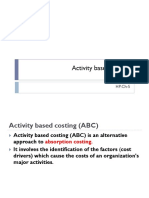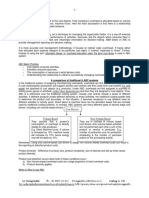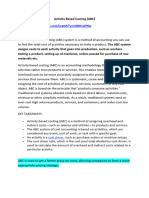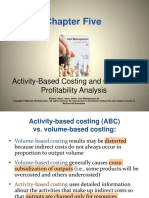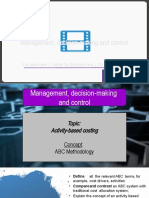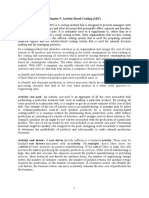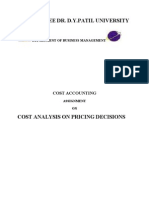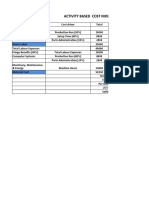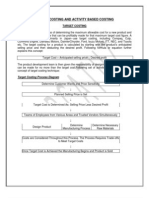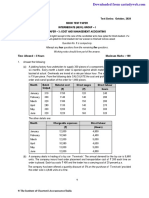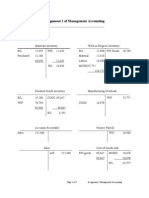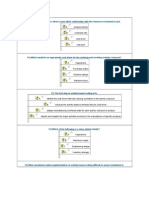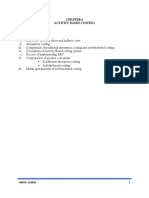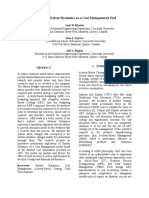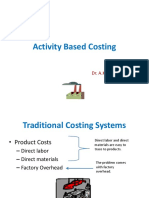CHAPTER
ACTIVITY BASED COSTING
2.1.0 Definition and concept
Activity based costing is an approach to the costing and monitoring of activities which
involves tracing resource consumption and costing final outputs. Resources are
assigned to activities, and activities to cost objects based on consumption estimates.
The latter utilise cost drivers to attach activity costs to outputs (CIMA Official
Terminology, 2005).
2.1.1 Overview
The concept of ABC was first defined in the late 1980s by Robert Kaplan and William
Burns. Initially ABC focused on manufacturing industry where technological
developments and productivity improvements had reduced the proportion of direct
labour and material costs, but increased the proportion of indirect or overhead costs.
2.2.1 Comparison of traditional costing and ABC
The traditional method of costing relied on the arbitrary addition of a proportion of
overhead costs on to direct costs to attain a total product cost. The traditional
approach to cost allocation relies on three basic steps.
1. Accumulate costs within a production or non-production department.
2. Allocate non-production costs to production departments.
3. Allocate the resulting production department costs to various products, services
or customers.
This type of costing system usually allocates costs based on a single volume measure,
such as direct labour hours or machine hours. While using such a simplistic volume
measure to allocate overheads as an overall cost driver, this approach seldom meets
the cause-and-effect criteria desired in accurate cost allocation.
Figure 2.1: Traditional Costing System
Overhead Cost Accounts
(For each individual category of expenses e.g property taxes, depreciation etc.)
1st stage
Allocation
(1) Cost Centres (2) Cost Centres (N) Cost Centres
(Departments) (Departments) (Departments)
2nd stage Absorption
(direct labour or machine hour)
Direct cost
Cost objects (products, services and customers)
1
� This method of costing has become increasing inaccurate as the relative proportion of
overhead costs has risen. This distortion of costs can result in inappropriate decision
making.
ABC is therefore an alternative approach to the traditional method or arbitrary
allocation of overheads to product, services and customers.
Figure 2.2: Activity Based Costing System
Overhead Cost Accounts
(For each individual category of expenses e.g property taxes, depreciation etc.)
1st stage
Allocation (Resource cost drivers)
(1) Activity Cost (2) Activity Cost (N) Activity Cost
Centres Centres Centres
2nd stage Allocations
(activity cost drivers)
Direct costs
Cost objects (products, services and customers)
Figure 2.3: Framework of activity based costing
2.2.2 Application
In contrast to traditional cost accounting systems, ABC systems first accumulate
overheads for each organisational activity. They then assign the costs of these
activities to products, services or customers (referred to as cost objects) causing that
activity.
The initial activity analysis is clearly the most difficult aspect of ABC. Activity analysis
is the process of identifying appropriate output measures of activities and resources
(cost drivers) and their effects on the costs of making a product or providing a service.
ABC systems have the flexibility to provide special reports so that management can
take decisions about the costs of designing, selling and delivering a product or service.
The key aspect is that ABC focuses on accumulating costs via activities, whereas
traditional cost allocation focuses on accumulating costs within functional areas.
2
� The main advantage of ABC is that it minimises or avoids distortions on product costs
that might occur from arbitrary allocation of overhead costs.
2.2.3 Steps in Development of an ABC System
ABC uses cost drivers to assign the costs of resources to activities and unit cost as a
way of measuring an output.
There are four steps to implementing ABC.
1. Identify activities
The organisation needs to undertake an in-depth analysis of the operating
processes of each responsibility centre. Each process might consist of one or more
activities required to produce an output.
2. Assign resource costs to activities
This involves tracing costs to cost objects to determine why the cost occurred.
Costs can be categorised in three ways:
i. Direct – costs that can be traced directly to one output. For example, the
wood and paint that it takes to make a chair.
ii. Indirect – costs that cannot be allocated to an individual output, that is,
they benefit two or more outputs, but not all outputs. For example,
maintenance costs or storage costs.
iii. General/administration – costs that cannot be associated with any
product or service. These costs are likely to remain unchanged, whatever
output is produced. For example, salaries of administration staff, security
costs or depreciation.
3. Identify outputs
Identify all of the output for which an activity segment performs activities and
consumes resources. Outputs might be products, services or customers.
4. Assign activity costs to outputs
This is done using activity drivers. Activity drivers assign activity costs to outputs
(cost objects) based on the consumption or demand for activities.
Example 1
After attending a management accounting course on activity-based costing (ABC) you
decide to experiment by applying the principles of ABC to the four products currently
made and sold by your company. Details of the four products and relevant information
are given below for one period:
3
�Product A B C D
Output in units 120 100 80 120
Costs per unit: K K K K
Direct material 40 50 30 60
Direct labour 28 21 14 21
Machine hours (per unit) 4 3 2 3
The four products are similar and are usually produced in production runs of 20 units
and sold in batches of 10 units.
The production overhead is currently absorbed by using a machine hour rate, and the
total of the production overhead for the period has been analysed as follows:
K
Machine department costs (rent, business rates,
depreciation and supervision) 10,430
Set-up costs 5,250
Stores receiving 3,600
Inspection/quality control 2,100
Materials handling and dispatch 4,620
You have ascertained that the cost drivers to be used are as listed below for the
overhead costs shown:
Cost Cost driver
Set-up costs Number of production runs
Stores receiving Requisitions raised
Inspection/quality control Number of production runs
Materials handling and dispatch Orders executed
The number of requisitions raised on the store was 20 for each product and the
number of orders executed was 42, each order being for a batch of 10 of a product.
You are require:
a) to calculate the total costs for each product using traditional approach if all
overhead costs are absorbed on a machine hour basis;
b) to calculate the total costs for each product, using activity-based costing;
c) to calculate and list the unit product costs from your figures in (a) and (b) above,
to show the differences and to comment briefly on any conclusions which may be
drawn which could have pricing and profit implications.
Solution
4
�a) Total machine hours = (120 x 4 hrs) + (100 x 3 hrs) + (80 x 2 hrs) + (120 x 3 hrs)
= 1,300 hours
K10,430 +K5,250 + K3,600 + K2,100 + K4,620
Machine hour overhead rate =
1,300 hrs
= K20 per machine hour
Therefore;
Product A B C D
K K K K
Direct material 40 50 30 60
Direct labour 28 21 14 21
Overhead @ K20 per machine hour 80 60 40 60
148 131 84 141
Units of output 120 100 80 120
Total cost (output x unit cost) K17,760 K13,100 K6,720 K16,920
b) Using ABC
Cost
per
Cost driver unit
Costs K Cost driver transactions (K)
Machine department 10,430.00 Machine hours 1,300 hours 8.02
Set-up costs 5,250.00 Production runs* 21 250.00
Stores receiving 3,600.00 Requisitions 80 45.00
raised**
Inspection/quality 2,100.00 Production runs 21 100.00
control
Materials handling 4,620.00 Number of order 42 110.00
executed***
120+100 + 80+120 420
*Production runs = = = 21 set-ups
20 20
**Requisitions = 20 x 4 products = 80 requisitions
420
***Number of orders executed = = 42 orders
10
5
�Therefore;
A B C D
K K K K
Prime cost 8,160 7,100 3,520 9,750
Set-ups 1,500 1,250 1,000 1,500
Stores/receiving 900 900 900 900
Inspection/quality 600 500 400 600
Handling dispatch 1,320 1,100 880 1,320
Machine department cost 3,851 2,407 1,284 2,888
16,331 13,257 7,984 16,928
Example 2
W is a manufacturing company that produces three products: X, Y and Z. Each uses
the same resources, but in different quantities as shown in the table of budgeted data
for 2018.
Product X Y Z
Budgeted production 1 500 2 500 4 000
Direct labour hours per unit 2 4 3
Machine hours per unit 3 2 3
Batch size 50 100 500
Machine setups per batch 2 3 1
Purchase orders per batch 4 4 6
Material movements per batch 10 5 4
W’s budgeted production overheads costs for 2018 are K400,000 and current practice
is to absorb these costs into product costs using an absorption rate based on direct
labour hours. As a result the production overhead cost attributed to each product unit
is:
Product X – K32 Product Y - K64 Product Z – K48
The management of W are considering changing to an activity based method of
attributing overhead costs to products and as a result have identified the following
cost drivers and related cost pools:
Cost pool K Cost driver
Machine maintenance 100,000 machine hours
Machine setups 70,000 machine setups
Purchasing 90,000 purchase orders
Material handling 60,000 material movements
6
� The remaining K80,000 of overhead costs are caused by a number of different factors
and activities that are mainly labour related and are to be attributed to products on
the basis of labour hours.
Required:
Calculate the production overhead cost attributed to each product unit using an
activity based approach.
Solution
The calculation of cost driver rates is as follows;
K100,000
1. Maintenance – machine =
(1,500 x 3) +(2,500 x 2) + (4,000 x 3)
= K4.65 per machine hour
K70,000
2. Machine set-up = 1,500 2,500 4,000 = K489.51 per set-up
( 50 x 2) + ( 100 x 3) + ( 500 x 1)
K90,000
3. Purchasing = 1,500 2,500 4,000 = K335.82 per order
( 50 x 4) + ( 100 x 4) + ( 500 x 6)
K60,000
4. Material handling = 1,500 2,500 4,000 = K131.29 per handling
( 50 x 10) + ( 100 x 5) + ( 500 x 4)
K80,000
5. Other costs = = K3.20 per labour hour
(1,500 x 2) +(2,500 x 4) + (4,000 x 3)
Therefore;
Product X Y Z
K K K
Batch cost:
Machine set-up 979.00 1,468.50 489.50
Purchasing 1,343.00 1,343.00 2,015.00
Material handling 1,313.00 656.50 525.00
3,635.00 3,468.00 3,029.50
Batch size 50 100 500
K K K
Unitised batch costs 72.70 34.68 6.06
Machine maintenance 13.95 9.30 13.95
Other overhead costs 6.40 12.80 9.60
Production overhead cost 93.05 56.78 29.61
2.3.0 ABC in practice
7
�ABC activities have been around for nearly 20 years and many companies in a variety
of sectors have implemented activity based thinking. ABC and ABM have brought
about radical changes in cost management systems. The principles and philosophies
of activity based thinking apply equally to service companies, government agencies,
process and manufacturing industries.
Management practices and methods have changed over the last decade and will
continue to change. Organisations have moved from managing vertically to managing
horizontally. There has also been a move from a function orientation to a process
orientation.
However, management information systems to track and provide information about
the horizontal aspects of business have lagged significantly behind managers’ needs.
ABC and ABM fill this information gap by providing cost and operation information
that mirrors a horizontal view.
ABC focuses on accurate information about the true cost of products, services,
processes, activities and customers. Using ABC, organisations gain a thorough
understanding of their business processes and cost behaviour during ABC analysis.
Management then applies this insight to improve decision making at operating and
strategic levels. This is then known as Activity Based Management (ABM). Simply, ABM
is ABC in action.
Advantages of ABC
ABC provides a more accurate method of costing of products and services.
It allows for a better and more comprehensive understanding of overheads and
what causes them to occur.
It makes costly and non-value adding activities more visible, so allowing managers
to focus on these areas to reduce or eliminate them.
It supports other management techniques such as continuous improvement,
scorecards and performance management.
Disadvantages of ABC
ABC can be difficult and time consuming to collect the data about activities and
cost drivers.
It can be costly to implement, run and manage an ABC system.
Even in ABC some overhead costs are difficult to assign to products and customers.
These costs still have to be arbitrarily applied to products and customers.
END OF CHAPTER





